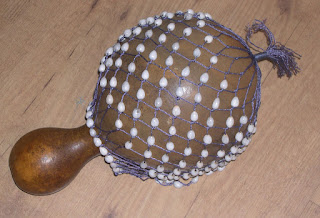
The shekere is a handmade rattle. It consists of a hollow gourd or calabash, covered on the outside with a net of seeds, beads, shells, or any available material. Although its origins are West African, today it is found in the Americas and Caribbean as well.
The calabash or gourd (as it's commonly known in the United States) is a functional creation of nature with a wide variety of uses and traditions in cultures around the world. A fruit of varied shape and size, it commonly grows on a vine not unlike the squash, but there are also varieties that grow on bushes and trees. In so-called "third world" countries the calabash was historically used as a container for water, and still is an essential utensil in many parts of the world. In rural areas of the U.S., they are often used as birdhouses. Throughout Asia, Africa, the Pacific Islands, the Caribbean and the Americas, gourds are used as resonators for musical instruments.
"Shekere" is a general name to describe the beaded gourd rattle. It comes in many shapes and sizes, is played in a variety of styles, and has many different names. In Africa it is found primarily, but not exclusively, in the countries of Nigeria, Togo, Ghana, Benin, Sierra Leone and Côte d'Ivoire (there are many parts of Africa where you will not hear this instrument). Different language groups in each country often have their own names, styles, techniques, and traditions associated with the shekere.
In Nigeria, the very large beaded calabash is called an "agbe", and traditionally is owned and played only by professional musicians (Olatunji, Music in African Life). It is a personal instrument and never loaned of shared, even with family members. However, a son who is a professional musician may inherit his father's agbe. Shekeres among the Yeruba of Nigeria are often connected with religion, given great respect, and play a very important role in certain traditional musical forms.
Throughout West Africa you will also a smaller gourd, covered with a woven net which is tied off at the bottom, leaving a tail of loose strings. In Ghana and Togo among the Ewe language group it is known as the "axatse" and is often used to accompany a drum or bell orchestra on important occasions. In Sierra Leone you will find a similar type of shekere with a very loose net an long tail, often called a "shake-shake" or "shaburay".
When African slaves were taken to the "New World," they carried with them many of these rich musical traditions, which took root in varying degrees in different parts of the Americas and the Caribbean. In Cuba, Youruba religious traditions using drums and shekeres are found almost completely intact - with similar rhythmic patterns, names of instruments and accompanying chants. Brazilians sometimes use a beaded (with seeds) coconut called "afuxe" similar in name and style to the Ghanian "axatse". In the United States the shekere and other African related instruments continue to grown in popularity and are rapidly becoming part of our contemporary musical expression.

Post a Comment